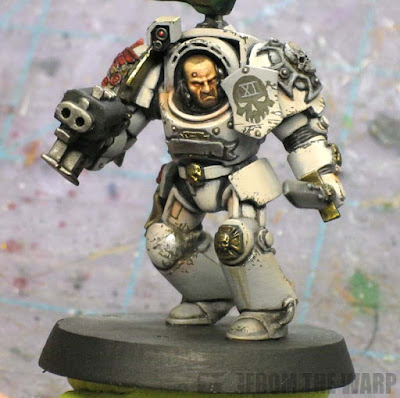
I got a reader question the other day about painting rich colored skin tones. The best example I can think of it in my recent work has been my Deathwing Terminator Sergeant model. The skin is super saturated and rich in color.
So how did I get the skin tones like that?
To get this particular skin tone, I started with a light grey primer. This made it so my lighter colors weren't darkened down and it saved me from having to apply multiple coats to get good solid coverage. The light grey color is the perfect answer for me.
I think the base color really sets up the "feel" of the skin in the end. Here I used GW Dwarf Flesh as my basecoat. As skin tones go, it's fairly dark, but it's a vibrant color. Over that goes two passes with GW wash Ogryn Flesh. This also darkens it down some more. The last bit of shading I do is in the deepest recesses only like the eye sockets and around the neck joint and it's done with GW wash Devlan Mud. Once this is completely dry, this is where I start to build the highlights up from.
The next step is adding some of the original base color back in as highlights. I pick out some of the more prominent edges and surfaces to bring back up to the original base color. Places like the cheeckbones, nose and forehead.
The second and final highlight is done with another vibrant color, GW Elf Flesh. I thin it slightly and hit only the very upper portions of the face. The bridge of the nose, the top edge of the forehead and maybe a spot on the cheekbones. I don't go over every previous highlight again, I just pick out the upper portions for effect.

The reason I don't add white to the base color is because I don't want it to wash out. I'd rather use another lighter, rich color instead to keep the life in there. It also adds some variety to the skin tone overall and I don't just have different values of one color.
To finish off the whole thing, you can go the extra distance and paint on facial stubble or a shaved head look where appropriate.
Why painting skin muted or vibrant matters
While it might not seem that important, the look you give your skin tones will affect the overall look and feel of your army. By that, I mean painting your pale Dark Eldar models to look as though they've just come from a week long vacation at the beach doesn't convey that unhealthy, sick look to them. In this case, a more muted, pale look might be more effective in conveying that feeling to your models.
Want to make your Imperial Guard unit look fresh from their home planet? Give them nice, warm skin tones, clean uniforms and no battle damage. Everyone who looks at them will think they are fresh from recruit school. Give them pale skin tones, a little bit of weathering and next thing you know, you have a battle hardened squad that hasn't had a break from fighting in months.
Take a look at my Deathwing Sergeant vs my Black Dragon marine:


One of them looks like he is well fed and healthy. He looks vibrant and full of life. He might be a bit rugged and worn around the edges like any good guy should, but he looks alive. The other guy does not. He doesn't look quite as healthy and maybe even like something is wrong with him.
To add another aspect to my Deathwing model, the skin is saturated, but the armour is not. It gives him (the man inside the machine) a very real and life-like look where the armour looks lifeless and just mechanical. It also helps draw the focus to his face.
Skin tones might be a small part of the whole picture, but definitely matter
How you paint your skin tones is only a small part of the overall look you give your army. Other things will help reinforce the feeling you're going for or work against you. The trick is matching things up to point your viewers in the direction you want them to go.
You can get this saturated look with other colors as well. Just make sure they are rich, you don't wash them out by adding black, white or a complimentary color and try using a few different colors instead of multiple values of a single color. It can get way more complicated than this when it comes to painting skin tones, but this should get you started with a good tabletop result.
Make sure to check out these posts as they might help:
Painting shaved heads and facial stubble
Painting Raven Guard pale skin tones
Painting Dark Eldar skin tones
